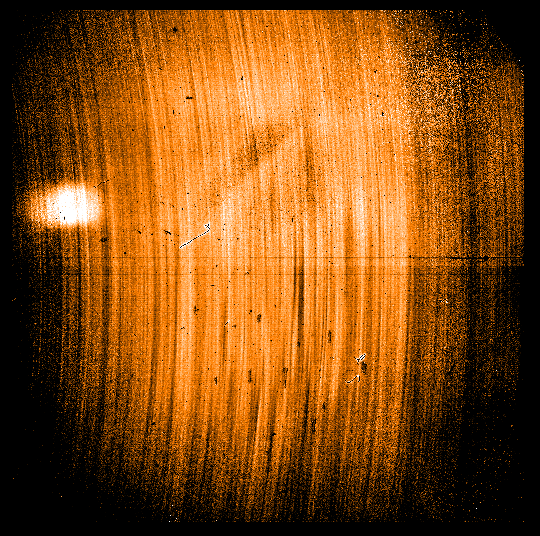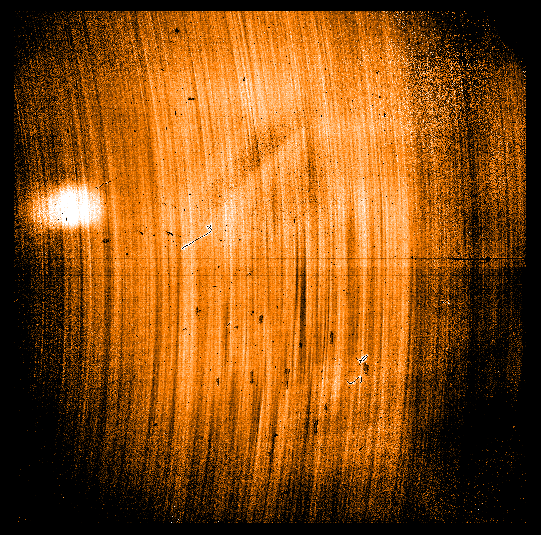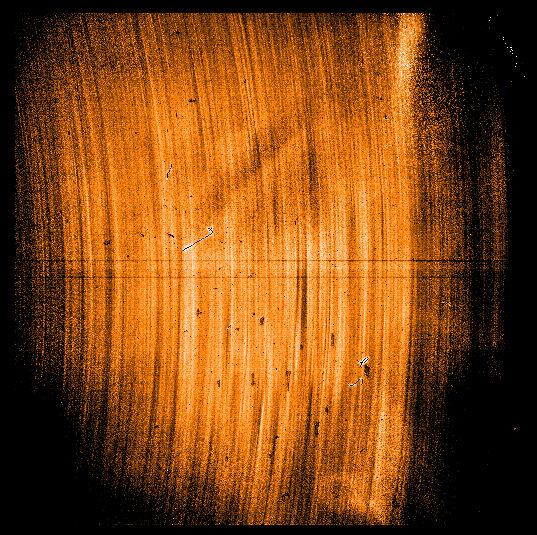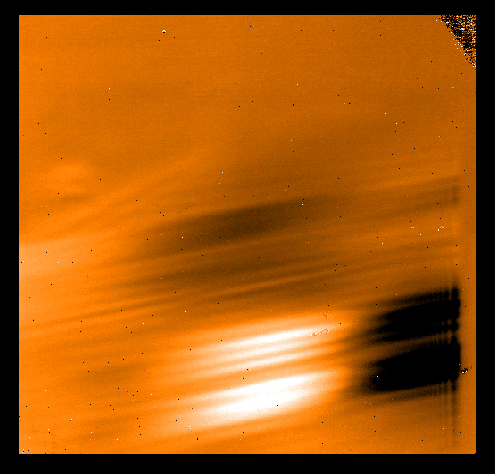 mirror sites:
PL (internal link)
HQ
[?]
mirror sites:
PL (internal link)
HQ
[?]
Quality Control and
Data Processing
|
NACO: Twilight flat quality
Twilight flat frames are acquired as a technical calibration in H, J and K. They are used to check if it is justified to calibrate NACO science frames with lamp flat frames of the corresponding filter and camera instead of using twilight flats. The sequence of flats acquired within the template shows an decreasing number of counts due to the sky is getting darker during dawn. In L and M band, sky flats are acquired to calibrate science data, because there is no flat lamp for the L and M band. The sky flat template acquires 15 frames at three different air masses to use the sky brightness gradient of the hemisphere to achieve flats with different count levels. The sky flat template is also launched during dawn. Example master twilight flats are from 2017. (The bad columns in the lower left (LL) detector quadrant are not visible, since the screen shot shows every second pixel)
 Ratio between twilight flat and lamp flat
Ratio between twilight flat and lamp flat
This parameter is meant to monitor the difference between the twilight flat and the lamp flat. sky flat frames, lamp flat frames and science exposures are subject to non-reproducible erratic light matching the lower of the detector. Each time the camera wheel is moved, the structure of the erratic light changes.
NONE Scoring&thresholds Ratio between twilight flat and lamp flat The RMS in the lower right quadrant and partly in the lower left quadrant is dominated by a large scale diagonal structure. It is caused by light leakage. The pattern changes as soon as the camera is changed. The QC parameter has been introduced in 2016 and have been regenerated for data acquired from 2015 on. Since 2015: The lower part of the detector, in particular the lower right quadrant suffers from a skewed large scale light leakage, visible in long exposure (large DIT) darks frames, in lamp flats, in twilight flats and in science images. The pattern changes as soon as the camera wheel (with S13, S27, S54 ...) moves in and out. Therefore the position of the contamination is not reproducible. As the erratic light is additive, the instrumental feature cannot be calibrated via flat fielding. The JHK band NACO calibration plan foresees close in time lamp flats to calibrate science observations. Twilight flats, as technical calibration, are used to cross check against lamp flats to justify the usage of lamp flat for the science. Since neither lamp flats nor twilight flats are able to calibrate the lower part of the NACO detector (see Fig. History3), the calibration scheme is currently confined to the upper part of the detector.
Algorithm Ratio between twilight flat and lamp flat The master twilight flat is subtracted by the closest in time acquired master lamp flat of the same instrumental setup (readout mode, filter and camera) and the product is squared. The square root of the sum of all pixel in a rim-stripped area is obtained and monitored.  Bad pixel number
Bad pixel number
The twilight flat recipe returns a bad pixel map and the number of bad pixel of the whole detector as a QC1 parameter. For some periods from 2015 on the upper right or the lower left detector quadrant are subject of dead columns (usually every eights column is affected, but other patterns are observed as well). Number of bad pixel in these quadrants is dominated by the dead columns.
The number of bad pixel, derived from twilight flats is monitored per detector quadrant. Scoring&thresholds Bad pixel number The QC parameter is not scored.
Monitoring is introduced in 2015.
The pipeline generated bad pixel map is analyzed. All bad pixel in a rim-stripped area of each detector quadrant is summed up.  Error map of the twilight flat
Error map of the twilight flat
The errormap pipeline product shows the error bars of the individual pixel of the master twilight flat. In case one of the raw frames is contaminated by air plane tracks or stars, they show up in the error map as larger RMS values.
Scoring&thresholds Error map of the twilight flat This parameter is not scored None Algorithm Error map of the twilight flat The pipeline generated error map is analyzed. All the mean value in a rim-stripped area of each detector quadrant is calculated. |
||||||||||||||||||||||||||||||||||||||||||||||||||||||||||||||||||||||||||||||||||||||||||||||||||||||||||||||||||||||||||||||||||||||||||||||||||||||||||||||||||||||||||||||||||||||||||||||||||||||||||||||||||||||||||||||||||||||||||||||||||||||||||||||||||||||||||||||||||||||||||||||||||||||||||||||||||||||||||||||||||||||||||||||||||||||||||||||||||||||||||||||||||||||||||||||||||||||||||||||||||||||||||||||||||||||||||||||||||||||||||||||||||||||||||||||||||||||||||||||||||||||||||||||||||||||||||||||||||||||||||||||||||||||||||||||||||||||||||||||||||||||||||||||||||||||||
| |
|||||||||||||||||||||||||||||||||||||||||||||||||||||||||||||||||||||||||||||||||||||||||||||||||||||||||||||||||||||||||||||||||||||||||||||||||||||||||||||||||||||||||||||||||||||||||||||||||||||||||||||||||||||||||||||||||||||||||||||||||||||||||||||||||||||||||||||||||||||||||||||||||||||||||||||||||||||||||||||||||||||||||||||||||||||||||||||||||||||||||||||||||||||||||||||||||||||||||||||||||||||||||||||||||||||||||||||||||||||||||||||||||||||||||||||||||||||||||||||||||||||||||||||||||||||||||||||||||||||||||||||||||||||||||||||||||||||||||||||||||||||||||||||||||||||||||
 |
|
||||||||||||||||||||||||||||||||||||||||||||||||||||||||||||||||||||||||||||||||||||||||||||||||||||||||||||||||||||||||||||||||||||||||||||||||||||||||||||||||||||||||||||||||||||||||||||||||||||||||||||||||||||||||||||||||||||||||||||||||||||||||||||||||||||||||||||||||||||||||||||||||||||||||||||||||||||||||||||||||||||||||||||||||||||||||||||||||||||||||||||||||||||||||||||||||||||||||||||||||||||||||||||||||||||||||||||||||||||||||||||||||||||||||||||||||||||||||||||||||||||||||||||||||||||||||||||||||||||||||||||||||||||||||||||||||||||||||||||||||||||||||||||||||||||||||



